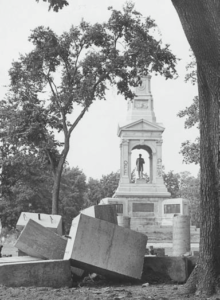
Art installation ‘Forgotten Souls of Tory Row’ coming down, presence of enslaved remains
Above Image: The “Forgotten Souls of Tory Row” art installation seen Dec. 12 in West Cambridge. (Photo: History Cambridge)
By Beth Folsom
“Forgotten Souls of Tory Row: Remembering the Enslaved People of Brattle Street” was installed on the lawn of the Hooper-Lee-Nichols House in West Cambridge in May. As the headquarters of History Cambridge, and the second-oldest surviving house in the city, the Hooper-Lee-Nichols House has a long and complex history. Although we do not have direct evidence that enslaved individuals lived on the property, we do know that at least three previous owners of the house enslaved people on other properties they owned, and that their enslaved servants would undoubtedly have traveled with them when they visited their house on Brattle Street. In addition, we know that many of the white residents of the area, often called Tory Row, did enslave people in their Cambridge houses, and that enslaved people lived, worked and visited this area in the 17th and 18th centuries.
Some Cambridge families, including those in West Cambridge and the residents of Brattle Street, made their wealth through enslaved labor in Jamaica and enslaved people at homes and estates. Joseph and Rebecca Lee, the owners of the Hooper-Lee-Nichols House, were complicit in this economy. History Cambridge has been engaged in the important work of uncovering the history of enslavement through our research and public programs, including our Tory Row Antiracism Coalition.
Last year, History Cambridge was fortunate to get a grant from Cambridge Arts and the Mass Cultural Council to create a temporary public art installation to help bring attention to the presence of these enslaved people on the land around our headquarters. Designed by the artists of Black Coral, “Forgotten Souls of Tory Row: Remembering the Enslaved People of Brattle Street” honors the enslaved adults and children who lived and worked on this land as well as those whose labor on Caribbean plantations helped finance the grand homes of white Tory Row elites. Although we do not know all of the names or experiences of the enslaved people, we aim to honor their humanity through this installation and restore their physical presence to the land where they once lived and worked.
Originating in the Congo in West Africa and dating back to at least the ninth century, the bottle tree tradition was brought to the United States by enslaved people, most notably those who lived in Georgia and South Carolina. This tradition was passed down through generations of enslaved and, later, free Black communities, marking the survival of a cultural practice despite the bonds of slavery. The distinctive blue bottles were placed on tree limbs to capture the energy, spirit and memories of ancestors.
“Forgotten Souls” will be removed from the HLN House lawn April 7 as its temporary installation comes to a close. During the 10 months of the art’s display, History Cambridge has held several programs on the piece, including a public celebration with a libation ceremony, readings and a drum invocation, as well as a discussion with the artists. History Cambridge has tried to capture as many reactions to the installation as possible through a visitor survey, which will remain open for comments. Reactions have been overwhelmingly positive, with many respondents saying they were largely unaware of the legacy of enslavement in Cambridge. One visitor noted that “I had never really considered how much of the wealth broadly across New England is anchored in enslaved labor. I knew about Newport and the [wealth] there but hadn’t thought of it in Cambridge.” Another said, “I had always suspected there may have been slavery on Brattle Street. Thank you for confirming it!”
Most important to those who viewed this piece was the way in which it humanized the larger systemic issues of enslavement and racism. One visitor noted that “reading the names made them real to me,” and another commented that “anonymous does not mean unknown.” For those who work on Tory Row today, the connection to those who have lived and worked in this place is especially powerful, as one visitor observed: “The installation is quite striking along the shaded manicured lawns of Brattle Street. I work here as a gardener tending these gardens and was struck by a feeling of kinship with those souls who also labored here.”
The necessary and important work of uncovering and sharing the stories of those enslaved on Brattle Street continues, and History Cambridge wants you to join us on this journey. We welcome visitors to the Hooper-Lee-Nichols House, 159 Brattle St., West Cambridge, for this final week of “Forgotten Souls,” and we invite you to visit our website and sign up for our newsletter, where you can learn more about all of our work, including our antiracism initiatives and programs on the history of traditionally marginalized communities in Cambridge history.
Beth Folsom is programs manager for History Cambridge.
This article was originally published in our “Did You Know?” column in Cambridge Day.






